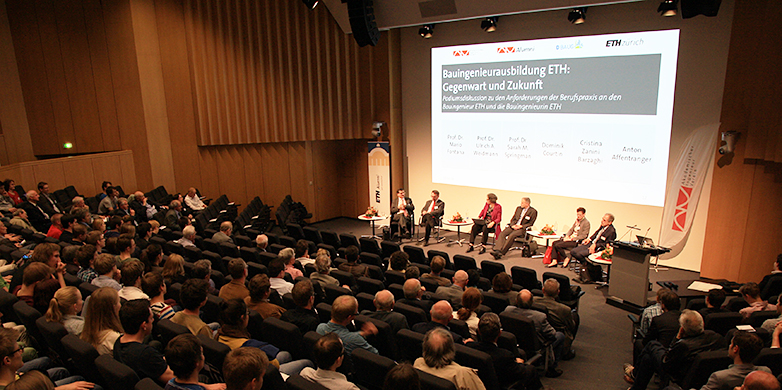Training engaged in a balancing act
Do future civil engineers at ETH Zurich really learn what they will need in their working lives? And what will their training look like in future? A panel with representatives of the Department of Civil, Environmental and Geomatic Engineering and industry discussed these topics.
The profession of the civil engineer is a dream profession. “In the land of tunnels and bridges these experts create structures that last a long time and are of major social relevance”, stressed Professor Ulrich Weidmann, head of the Department of Civil, Environmental and Geomatic Engineering at the start of the event. Hence, it was important to keep the long-term perspective in mind and to consider social contexts.
At ETH Zurich the training of civil engineers can look back on a long tradition. Nonetheless, this raises the question whether the training has kept pace with today’s requirements. This prompted the Academic Engineering Association (AIV) to organise a panel discussion and ask the concrete question, “Which areas should be given more weighting in the training course?
A roundabout in Taipeh is different
Anton Affentranger, CEO Implenia AG, gave a clear answer. “I would like to see more people who think outside the box, who don’t just tackle projects from the technical angle but are capable of multi-dimensional thinking”. The CEO of Basler & Hoffmann AG, Dominik Courtin, voiced a similar opinion. Civil engineers had to take society and the environs into account. “An engineer must bear in mind that a roundabout in Switzerland won’t look the same as one in Taipeh”, explained Courtin. These two statements already highlight the difficult balancing act facing training of this kind. On the one hand, the students must be given sound technical training. On the other, the demands for a multi-disciplinary approach and social and leadership skills are on the rise. Sarah Springman, Professor of Geotechnical Engineering, who chaired the discussions with a generous portion of British humour, took the opportunity to mention the plans for a new Master degree course “Integrated Building Systems”. It will be open to students from the autumn of 2014 from various disciplines and will promote this transdisciplinary thinking.
What the thickness of sheet steel reveals
Mario Fontana, Professor for Structural Engineering, raised another point: experience. It was very important to be able to correctly calculate the thickness of sheet steel but, in the final instance, an experienced civil engineer will go for the safer, thicker option. Industry would prefer a thinner one was the laughter-backed comment from the other side of the panel. The simple example of the sheet steel highlighted another area of possible tension: theory and practice. On the one hand, the ETH course of study is obliged to stick closely to the theory and basics but on the other it is also a vocational training course. The Lugano municipal councillor Christina Zanini Barzaghi pointed out that engineers were always in demand because of their solution-oriented approach, hence the balancing act between theory and practice was already possible today.
New use of buildings
Critical voices were also to be heard in the final question and answer session. Was the course at ETZ Zurich not innovative enough and was it perhaps missing the boat in terms of future requirements? Weidmann countered that the basics more or less remained the same but that the issues and initial situations may change. He gave as an example the preservation and changing use of buildings. “Today civil engineers must understand the complete life cycle of a building. This adaptability will become a key issue”, he said with conviction.
There was, however, agreement on one thing: the urgent need for more good civil engineers and – as Springman liked to stress at every opportunity – for female civil engineers, too. Courtin and Affentranger were both of the opinion that it was difficult to find enough good experts. Sometimes, interesting jobs even had to be refused because of a shortage of staff or because they weren’t flexible enough. However, it was clear from the representatives of the Department of Civil, Environmental and Geomatic Engineering on the panel that they would like the best Master students to stay on as doctoral students at ETH. This launched playful competition for the young talents in the audience. Future civil engineers seem to have chosen not only a dream profession but also one that is particularly resilient in times of crisis.

Comments
No comments yet